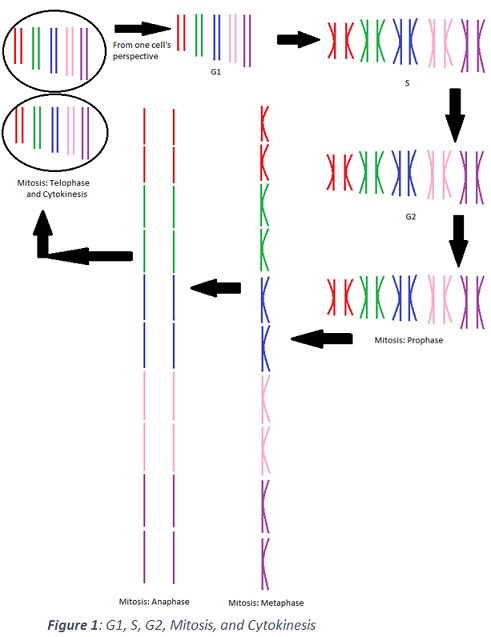Mitosis, Meiosis and the Cell Cycle Lab Exercise
Please read Chapter 6 of What is Life? A Guide to Biology before beginning this lab.
The purpose of this lab exercise is to understand how the chromosomes move during mitosis and meiosis and how the number of chromosomes increases and decreases as a cell goes through the cell cycle, mitosis and meiosis. A second objective is to understand that there can be errors in meiosis and that several genetic conditions in humans are caused by an increased number of chromosomes.
The cell cycle has two phases: interphase and cell division. Cell division can be either mitosis or meiosis. In mitosis, the parent cell divides to form 2 daughter cells that are genetically identical to the parent cell. Cells in the human body may be continually moving through the cell cycle and mitosis/cytokinesis or they may be permanently in interphase, depending upon the type of cell. The cells inside your mouth (cheek cells) are continually going through the cell cycle and dividing by mitosis. Other cells are dividing when needed (liver cells) and when not going through the cell cycle are in the G1 of interphase. Brain cells are not normally able to divide after they mature and are permanently in the G1 of interphase.
Ordinary cell division involves mitosis (division of the nucleus) and cytokinesis (division of the cytoplasm). Before the cell divides, it must duplicate its DNA in the S phase of interphase. After mitosis and cytokinesis, two daughter cells form that are genetically identical to the parent cell. In humans, the daughter cell has 46 chromosomes after mitosis, this is the diploid number (2N) of chromosomes. If the cell is going to divide again, it will duplicate its DNA in the S phase of interphase. After the S phase, the cell has 92 chromosomes (2 x 46). After the cell undergoes mitosis and cytokinesis, each of the two daughter cells will have 46 chromosomes. A flow chart illustrating the process of mitosis in an organism with 2N=10 is seen at the top of the following page in Figure 1.
A special type of cell division is meiosis. Once again, before the cell divides it must duplicate its DNA. After the human cell goes through meiosis, four daughter cells are formed and each has 23 chromosomes, the N or haploid number of chromosomes. In humans, the cells that are the product of meiosis are gametes, egg and sperm, each with 23 chromosomes. The daughter cells are all genetically different from the parent cell and each other. Only special cells in the reproductive system will undergo meiosis to make eggs and sperm, the gametes.
This lab exercise has 3 parts:
Part 1: In this lab exercise, make a flow chart to follow the chromosomes as they progress through the cell cycle starting with the G1-> S -> G2 ->meiosis and cytokinesis. For this cell, the diploid (2N) number of chromosomes = 10. Use Figure 1 to help you complete your flow chart for meiosis. Remember that mitosis (in Fig. 1) and meiosis are not identical. Figure 1 is an example of mitosis. At the end of meiosis, there should be 4 cells.

Part 2: List and briefly describe 5 different human conditions that are caused by an abnormal number of chromosomes. Provide the name of the condition and include the chromosome number of the chromosome that is not normal for humans.
Part 3: Select one of the human conditions listed in Part 2 and expand upon this condition. Which chromosome is extra? What characteristics do these individuals have? Is the chromosome an autosome or sex chromosome? Is this condition more often found in human males or females? Can the person be cured of the condition? Why or why not?